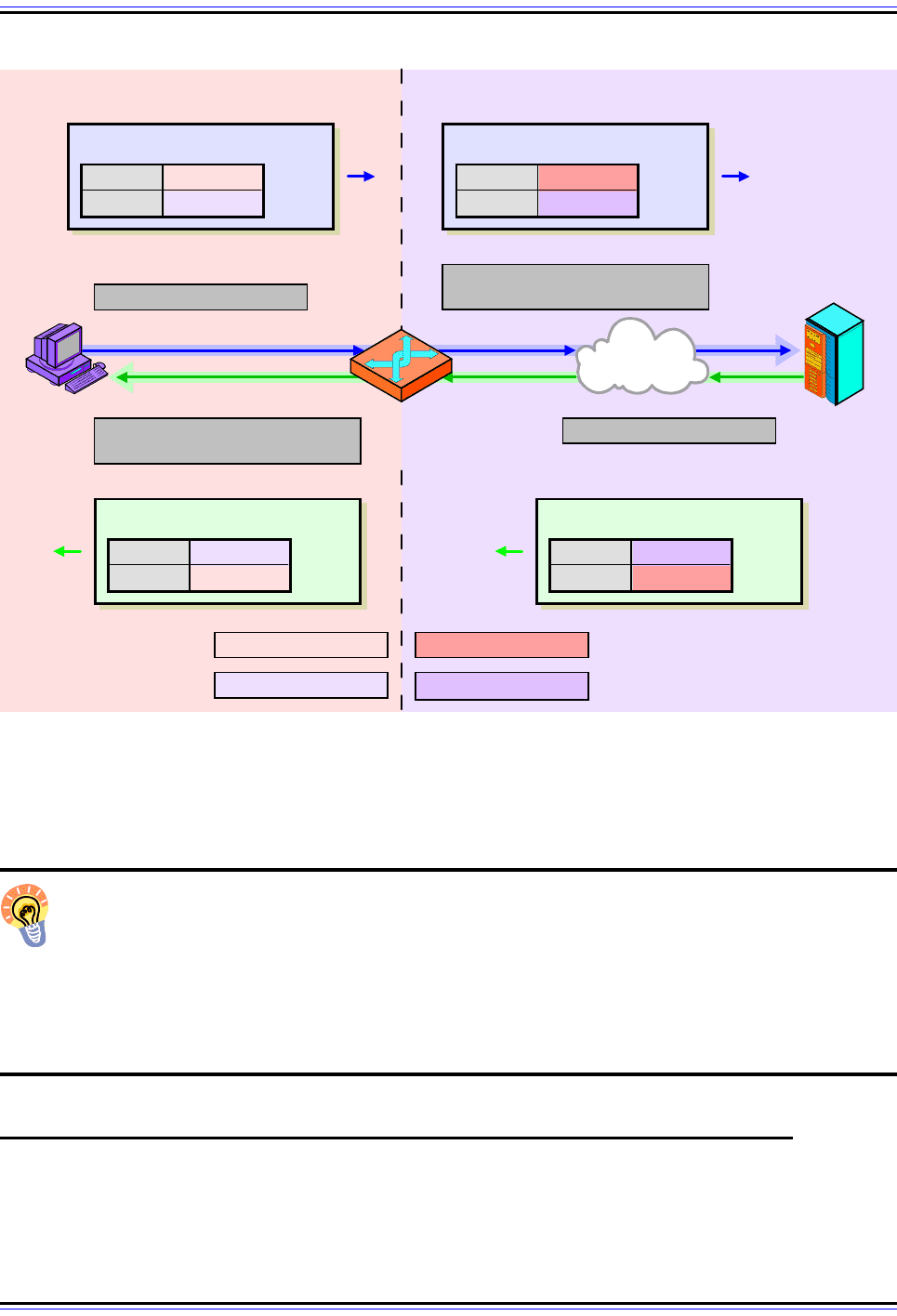Charles M. Kozierok The TCP-IP Guide
Подождите немного. Документ загружается.


The TCP/IP Guide - Version 3.0 (Contents) ` 541 _ © 2001-2005 Charles M. Kozierok. All Rights Reserved.
device address must still be translated as in regular NAT because 18.0.0.18 is not a valid
public address for us. It may refer to a real machine in MIT and we aren't supposed to be
using it on the Internet!
Let's say that we are still using the pool of 20 inside global addresses from 194.54.21.1
through 194.54.21.20 for inside addresses, and let's further suppose the NAT router
chooses 194.54.21.12 for this particular exchange. The transaction sequence would be
roughly as described in Table 78, and illustrated in Figure 115.
As you can see, in this example the outside local and outside global addresses are
different, unlike in the preceding NAT examples. Twice NAT can also handle an inbound
transaction, by watching for datagrams coming in from the Internet that overlap with the
addresses used on the local network and doing double substitutions as required.
Table 78: Operation Of “Overlapping” NAT / “Twice NAT”
Step
#
Description
Data-
gram
Type
Datagram
Source
Address
Datagram
Destination
Address
1
Inside Client Generates Request And Sends
To NAT Router: Device 18.0.0.18 generates a
request using the destination 172.16.44.55 that it
got from the (NAT-intercepted) DNS query for
“www.twicenat.mit.edu. The datagram is sent to
the NAT router for the local network.
Request
(from
inside
client to
outside
server)
18.0.0.18
(Inside Local)
172.16.44.55
(Outside Local)
2
NAT Router Translates Source Address And
Destination Address and Sends To Outside
Server: The NAT router makes two translations.
First, it substitutes the 18.0.0.18 address with a
publicly registered address, which is
194.54.21.12 for this example. It then translates
the bogus 172.16.44.55 back to the real MIT
address for “www.twicenat.mit.edu”. It routes the
datagram to the outside server.
194.54.21.12
(Inside Global)
18.1.2.3
(Outside Global)
3
Outside Server Generates Response And
Sends Back To NAT Router: The MIT server at
18.1.2.3 generates a response and sends it back
to 194.54.21.12, which causes it to arrive back at
the NAT router.
Response
(from
outside
server to
inside
client)
18.1.2.3
(Outside Global)
194.54.21.12
(Inside Global)
4
NAT Router Translates Source Address And
Destination Address And Delivers Datagram
To Inside Client: The NAT router translates back
the destination address to the actual address
being used for our inside client, as in regular NAT.
It also substitutes back in the 172.16.44.55 value
it is using as a substitute for the real address of
“www.twicenat.mit.edu”.
172.16.44.55
(Outside Local)
18.0.0.18
(Inside Local)

The TCP/IP Guide - Version 3.0 (Contents) ` 542 _ © 2001-2005 Charles M. Kozierok. All Rights Reserved.
Key Concept: “Overlapping” NAT is used in situations where both the source and
destination addresses in a datagram are private addresses or otherwise cannot be
used regularly on the public Internet. In this case, unlike the other types of NAT, the
NAT router translates both the source and destination addresses of incoming and outgoing
datagrams. On outgoing messages, inside local addresses are changed to inside global
and outside local to outside global; on incoming messages, inside global addresses are
changed to inside local and outside global to outside local.
IP NAT Compatibility Issues and Special Handling Requirements
In a perfect world, Network Address Translation could be made transparent to the devices
using it. We'd like to be able to have a NAT router change IP addresses in request
datagrams as they leave the network and change them back in responses that come back
and have none of the hosts be any the wiser. Unfortunately, this ain't a perfect world.
Figure 115: Operation Of “Overlapping” NAT / “Twice NAT”
This figure is very similar to Figure 112, except that the as you can see, both source and destination
addresses are translated by the NAT router each time (shown in bold). Table 78 contains a complete expla-
nation of the four steps in “overlapping” NAT. Refer to Figure 111 for an explanation of address types.
Source 18.0.0.18
Destination 172.16.44.55
Request
Source
194.54.21.12
Destination
18.1.2.3
Translated Request
Source
172.16.44.55
Destination
18.0.0.18
Translated Response
Source 18.1.2.3
Destination 194.54.21.12
Response
1. Client Sends Request
2. NAT Router Translates
Source & Destination Addresses
NAT
Router
3. Server Sends Response
Internet
4. NAT Router Translates
Source & Destination Addresses
Client
18.0.0.18
Server
18.1.2.3
Local Network
("Inside")
Public Internet
("Outside")
Inside Local Address
Outside Local Address
Inside Global Address
Outside Global Address

The TCP/IP Guide - Version 3.0 (Contents) ` 543 _ © 2001-2005 Charles M. Kozierok. All Rights Reserved.
It is not possible for NAT to be completely transparent to the devices that use it. There are
potential compatibility problems that arise if NAT doesn't perform certain functions that go
beyond simply swapping IP addresses and possibly port numbers in the IP header. The
main problem is that even though IP addresses are supposedly the domain of the Internet
Protocol, they are really used by other protocols as well, both at the network layer and in
higher layers. When NAT changes the IP address in an IP datagram, it must often also
change addresses in other places to make sure that the addresses in various headers and
payloads still match.
These compatibility issues require that even though NAT should theoretically work only at
the level of IP at the network layer, in practical terms NAT routers must be “aware” of many
more protocols and perform special operations as required. Some are required for all
datagrams that are translated, while others only apply to certain datagrams and not others.
And even when these techniques are added to NAT routers, some things still may not work
properly in a NAT environment.
Most NAT implementations do take these concerns into account. Certainly common appli-
cations like FTP are widely supported by NAT routers, or nobody would want to use NAT.
That said, there may be some applications that will not work over NAT. The fact that NAT
really isn't transparent and must do these extra sorts of “hacks” to other protocol headers
and even payloads is a big part of the reason why many people refer to NAT as a “kludge”;
elegant solutions don't have so many special cases that need special handling.
Let's take a look at some of the specific issues and requirements.
TCP and UDP Checksum Recalculations
Changing the IP addresses in the IP header means the IP header checksum must be calcu-
lated. Since both UDP or TCP also have checksums, and these checksums are computed
over a pseudo header that contains the IP source and destination address as well, they too
must be recalculated each time a translation is made.
ICMP Manipulations
Since NAT works so intimately with IP headers, and since IP is closely related to its
“assistant” protocol ICMP, NAT must also look for certain ICMP messages and make
changes to addresses contained within them. Many ICMP messages, such as Destination
Unreachable and Parameter Problem contain as data the original IP header of the
datagram that led to the ICMP message. Since NAT is translating addresses in IP headers
it must watch for these messages and translate addresses in included headers as required.
Applications That Embed IP Addresses
A number of TCP/IP applications embed IP addresses within the actual application data
payload. The most notorious example of this is the TCP/IP File Transfer Protocol (FTP),
which actually sends address and port assignments as text information in datagrams
between devices during a connection. In order for NAT to support FTP, it must be specifi-
cally programmed with algorithms to look for this information and make changes as needed.

The TCP/IP Guide - Version 3.0 (Contents) ` 544 _ © 2001-2005 Charles M. Kozierok. All Rights Reserved.
The level of complication can go even beyond this. Consider what happens when an FTP
message containing these text address or port numbers is fragmented—part of the address
to be translated may be in two different IP datagrams, and hard to recognize!
Additional Issues With Port Translation
When port-based NAT (PAT) is used, the issues that apply to addresses now apply to ports
as well, making even more work for the router to perform.
Cascading Impact Of Changes To Address Or Port Numbers
Take the example of an FTP datagram encoding an IP address that NAT must change. The
address being substituted might require more characters than the original; in our first
example, 10.0.0.207 (10 ASCII characters) is replaced by 194.54.21.11 (12 ASCII
characters). Making this substitution changes the size of the payload! This means that TCP
sequence numbers also must be modified.
In these situations, NAT itself is supposed to take care of any additional work that may be
required. This is definitely a complication that does not occur without the use of NAT, and is
an often-cited example of NAT’s “kludginess”.
Problems With IPSec
When IPSec is used in transport mode, both the Authentication Header (AH) and Encapsu-
lating Security Payload (ESP) protocols use an integrity check that is based on the value of
the entire payload. When NAT tries to update the TCP or UDP checksum in the IP
datagram, this changes the value of data that the receiving device uses in performing the
AH or ESP integrity check. The check will fail. Thus, NAT can't be used in IPSec transport
mode. It may still work in tunnel mode but there can be complications here as well.

The TCP/IP Guide - Version 3.0 (Contents) ` 545 _ © 2001-2005 Charles M. Kozierok. All Rights Reserved.
IP Security (IPSec) Protocols
One of the weaknesses of the original Internet Protocol is that it lacks any sort of general
purpose mechanism for ensuring the authenticity and privacy of data as it is passed over
the internetwork. Since IP datagrams must usually be routed between two devices over
unknown networks, any information in them is subject to being intercepted and even
possibly changed. With the increased use of the Internet for critical applications, security
enhancements were needed for IP. To this end, a set of protocols called IP Security or
IPSec was developed.
In this section I provide a brief description of IPSec concepts and protocols. I begin with an
overview of IPSec, including a discussion of the history of the technology and defining
standards. I describe the main components and protocols of the IPSec suite, and its
different architectures and methods for implementation. I then move to actually discussing
how IPSec works, beginning with a description of the two IPSec modes (transport and
tunnel) and how they differ. I describe security associations and related constructs such as
the Security Parameter Index (SPI). The last three topics cover the three main IPSec
protocols: IPSec Authentication Header (AH), IPSec Encapsulating Security Payload (ESP)
and the IPSec Internet Key Exchange (IKE).
Note: IPSec was initially developed with IPv6 in mind, but has been engineered to
provide security for both IPv4 and IPv6 networks, and operation in both versions is
similar. There are some differences in the datagram formats used for AH and ESP
depending on whether IPSec is used in IPv4 and IPv6, since the two versions have different
datagram formats and addressing. I highlight these differences where appropriate.
Note: There are many subjects in this Guide that are so involved that many large
books have been written about them. Security on IP networks and IPSec is
definitely in this category. Due to the already large size of this Guide and the
complexity of IPSec, I can only provide here a very limited description of how it works. For
more comprehensive information you will need to supplement with a reference specific to
this technology.
IPSec Overview, History and Standards
The best-known problem with the original Internet Protocol (IPv4) is the pending exhaustion
of its address space. This situation arose due to the rapid expansion of the Internet beyond
anyone's expectations when IPv4 was developed. This same mismatch between how the
Internet was when IPv4 was created and how it is now has led to another major problem
with IP: the lack of a definitive means of ensuring security on IP internetworks.

The TCP/IP Guide - Version 3.0 (Contents) ` 546 _ © 2001-2005 Charles M. Kozierok. All Rights Reserved.
The security problem arose because 25 years ago, the Internet was tiny and relatively
“private”. Today it is enormous and truly “public”. As the Internet has grown, the need for
security has grown with it. Consider that TCP/IP and the early Internet precursors were
developed as very small networks used by government researchers at the United States
Defense Advanced Research Projects Agency (DARPA or ARPA). All the hardware was
controlled by people who were well known and would generally have had security
clearance. In such a network, you don't need to build security in to the protocols—you build
it into the building! It's easier to use locks and guards to ensure security than fancy
encryption, when you can get away with it. After all, the easiest way to keep someone from
snooping or tampering with data on the network is simply to deny them access to the hosts
that connect to the network.
This worked fine at first when there were only a few dozen machines on the Internet. And
even when the Internet first started to grow, it was used pretty much only to connect
together researchers and other networking professionals. New sites were added to the
network slowly at first, and at least someone knew the identity of each new site added to the
growing internetwork. However, as the Internet continued to increase in size and eventually
was opened to the public, maintaining security of the network as a whole became impos-
sible. Today, the “great unwashed masses” are on the Internet. Many routers—owned by
“who knows” and administered by “who knows”—stand between you and most other
devices you want to connect with. You cannot assume that the data you send or receive is
secure.
A number of methods have evolved over the years to address the need for security. Most of
these are focused at the higher layers of the OSI protocol stack, to compensate for IP's lack
of security. These solutions are valuable for certain situations, but they can't be generalized
easily because they are particular to various applications. For example, we can use Secure
Sockets Layer (SSL) for certain applications like World Wide Web access or FTP, but there
are dozens of applications that this type of security was never intended to work with.
What was really needed was a solution to allow security at the IP level so all higher-layer
protocols in TCP/IP could take advantage of it. When the decision was made to develop a
new version of IP (IPv6), this was the golden opportunity to resolve not just the addressing
problems in the older IPv4, but the lack of security as well. New security technology was
developed with IPv6 in mind, but since IPv6 has taken years to develop and roll out, and the
need for security is now
, the solution was designed to be usable for both IPv4 and IPv6.
The technology that brings secure communications to the Internet Protocol is called IP
Security, commonly abbreviated IPSec (The capitalization of this abbreviation is variable,
so IPsec and IPSEC are also seen. Though not IpSeC or IPseC, fortunately. ☺)
Overview of IPSec Services and Functions
IPSec is not a single protocol, but rather a set of services and protocols that provide a
complete security solution for an IP network. These services and protocols combine to
provide various types of protection. Since IPSec works at the IP layer, it can provide these

The TCP/IP Guide - Version 3.0 (Contents) ` 547 _ © 2001-2005 Charles M. Kozierok. All Rights Reserved.
protections for any higher layer TCP/IP application or protocol without the need for
additional security methods, which is a major strength. Some of the kinds of protection
services offered by IPSec include:
☯ Encryption of user data for privacy.
☯ Authentication of the integrity of a message to ensure that it is not changed en route.
☯ Protection against certain types of security attacks, such as replay attacks.
☯ The ability for devices to negotiate the security algorithms and keys required to meet
their security needs.
☯ Two security modes, tunnel and transport, to meet different network needs.
Key Concept: IPSec is a contraction of IP Security, and consists of a set of services
and protocols that provide security to IP networks. It is defined by a sequence of
several Internet standards.
IPSec Standards
Since IPSec is actually a collection of techniques and protocols, it is not defined in a single
Internet standard. Instead, a collection of RFCs defines the architecture, services and
specific protocols used in IPSec. Some of the most important of these are shown in Table
79, all of which were published in November 1998:
Table 79: Important IP Security (IPSec) Standards
RFC
Number
Name Description
2401
Security Architecture for the
Internet Protocol
The main IPSec document, describing the architecture and
general operation of the technology, and showing how the
different components fit together.
2402 IP Authentication Header
Defines the IPSec Authentication Header (AH) protocol used for
ensuring data integrity and origin verification.
2403
The Use of HMAC-MD5-96
within ESP and AH
Describes a particular encryption algorithm for use by AH and
ESP called Message Digest 5 (MD5), HMAC variant.
(Obviously. ☺)
2404
The Use of HMAC-SHA-1-96
within ESP and AH
Describes a particular encryption algorithm for use by AH and
ESP called Secure Hash Algorithm 1 (SHA-1), HMAC variant.
(Naturally. ☺)
2406
IP Encapsulating Security
Payload (ESP)
Describes the IPSec Encapsulation Security Payload (ESP)
protocol that provides data encryption for confidentiality.
2408
Internet Security Association
and Key Management
Protocol (ISAKMP)
Defines methods for exchanging keys and negotiating security
associations.

The TCP/IP Guide - Version 3.0 (Contents) ` 548 _ © 2001-2005 Charles M. Kozierok. All Rights Reserved.
The Future of IPSec
Deployment of IPSec has only really started to take off in the last few years; a major use of
the technology is in implementing virtual private networks (VPNs). It appears that the future
IPSec is bright, as more and more individuals and companies decide that they need to take
advantage of the power of the Internet, while also protecting the security of the data they
transport over it.
IPSec General Operation, Components and Protocols
I have a confession to make: I considered not writing about IPSec in this Guide. When you
find yourself writing a tome as large as this one, you lose stamina sometimes and there's
this urge to avoid writing about confusing subjects. ☺ IPSec isn't the only difficult topic in
this Guide but it is definitely a subject that baffles many because it's hard to get your hands
around. Most discussions of it jump straight to describing the mechanisms and protocols
without providing a general description of what it does and how the pieces fit together. Well,
I recognized that IPSec is important and I don't shy away from a challenge. Thus, here's my
attempt to provide a framework for understanding IPSec's various bits and pieces.
So, what exactly does IPSec do and how does it do it? In general terms, it provides security
services at the IP layer for other TCP/IP protocols and applications to use. What this means
is that IPSec provides the tools that devices on a TCP/IP network need in order to commu-
nicate securely. When two devices (either end user hosts or intermediate devices such as
routers or firewalls) want to engage in secure communications, they set up a secure path
between themselves that may traverse across many insecure intermediate systems. To
accomplish this, they must perform (at least) the following tasks:
1. They must agree on a set of security protocols to use, so that each one sends data in
a format the other can understand.
2. They must decide on a specific encryption algorithm to use in encoding data.
3. They must exchange keys that are used to “unlock” data that has been cryptographi-
cally encoded.
4. Once this background work is completed, each device must use the protocols,
methods and keys previously agreed upon to encode data and send it across the
network.
2409
The Internet Key Exchange
(IKE)
Describes the Internet Key Exchange (IKE) protocol used to
negotiate security associations and exchange keys between
devices for secure communications. Based on ISAKMP and
OAKLEY.
2412
The OAKLEY Key Determi-
nation Protocol
Describes a generic protocol for key exchange.
Table 79: Important IP Security (IPSec) Standards
RFC
Number
Name Description

The TCP/IP Guide - Version 3.0 (Contents) ` 549 _ © 2001-2005 Charles M. Kozierok. All Rights Reserved.
IPSec Core Protocols
To support the activities above, a number of different components comprise the total
package known as “IPSec”, as shown in Figure 116. The two main pieces are a pair of
technologies sometimes called the core protocols of IPSec. These are the ones that
actually do the work of encoding information to ensure security. They are:
☯ IPSec Authentication Header (AH): This protocol provides authentication services
for IPSec. What this means is that it allows the recipient of a message to verify that the
supposed originator of a message was in fact the one that sent it. It also allows the
recipient to verify that none of the data in the datagram has been changed by any
intermediate devices en route. It also provides protection against so-called “replay”
attacks, where a message is captured by an unauthorized user and re-sent.
☯ Encapsulating Security Payload (ESP): The Authentication Header ensures integrity
of the data in datagram, but not its privacy. When the information in a datagram is “for
your eyes only”, it can be further protected using the ESP protocol, which encrypts the
payload of the IP datagram.
IPSec Support Components
AH and ESP are commonly called “protocols”, though this is another case where the validity
of this term is debatable. They are not really distinct protocols but are implemented as
headers that are inserted into IP datagrams, as we will see. They thus do the “grunt work” of
IPSec, and can be used together to provide both authentication and privacy. However, they
cannot operate on their own. For them to function properly they need the support of several
other protocols and services. The most important of these include:
Figure 116: Overview of IPSec Protocols and Components
IPSec Authentication
Header (AH)
Encapsulating Security
Payload (ESP)
IP Security Protocol Suite (IPSec)
Encryption/Hashing
Algorithms
Security Policies /
Security Associations
Internet Key Exchange
(IKE) / Key Management
IPSec Support Components
IPSec Core Protocols

The TCP/IP Guide - Version 3.0 (Contents) ` 550 _ © 2001-2005 Charles M. Kozierok. All Rights Reserved.
☯ Encryption/Hashing Algorithms: AH and ESP are generic and do not specify the
exact mechanism used for encryption. This gives them the flexibility to work with a
variety of such algorithms, and to negotiate which is used as needed. Two common
ones used with IPSec are Message Digest 5 (MD5) and Secure Hash Algorithm 1
(SHA-1). These are also called hashing algorithms because they work by computing a
formula called a hash based on input data and a key.
☯ Security Policies and Associations, and Management Methods: Since IPSec
provides flexibility in letting different devices decide how they want to implement
security, some means is required to keep track of the security relationships between
devices. This is done in IPSec using constructs called security policies and security
associations, and by providing ways to exchange security association information (see
below).
☯ Key Exchange Framework and Mechanism: For two devices to exchange encrypted
information they need to be able to share keys for unlocking the encryption. They also
need a way to exchange security association information. In IPSec, a protocol called
the Internet Key Exchange (IKE) provides these capabilities.
Key Concept: IPSec consists of a number of different components that work
together to provide security services. The two main ones are protocols called the
Authentication Header (AH) and Encapsulating Security Payload (ESP), which
provide authenticity and privacy to IP data in the form of special headers added to IP
datagrams.
Well, that's at least a start at providing a framework for understanding what IPSec is all
about and how the pieces fit together. We’ll examine these components and protocols in
more detail as we proceed through this section.
IPSec Architectures and Implementation Methods
The main reason that IPSec is so powerful is that it provides security to IP, the basis for all
other TCP/IP protocols. In protecting IP, we are protecting pretty much everything else in
TCP/IP as well. An important issue, then, is how exactly we get IPSec into IP? There are
several implementation methods for deploying IPSec, which represent different ways that
IPSec may modify the overall layer architecture of TCP/IP.
IPSec Implementation Methods
Three different implementation architectures are defined for IPSec in RFC 2401. Which one
we use depends on various factors including the version of IP used (v4 versus v6), the
requirements of the application and other factors. These in turn rest on a primary implemen-
tation decision: whether IPSec should be programmed into all hosts on a network, or just
into certain routers or other “intermediate devices”.
This implementation decision is one that must be based on the requirements of the network.
There are two options: to implement IPSec in end hosts, or in routers.
